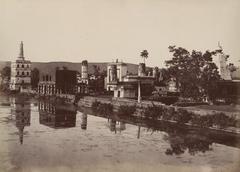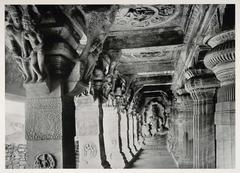
Banashankari Temple Visiting Guide: Hours, Tickets, and History
Date: 17/07/2024
Introduction
The Banashankari Temple, situated in Badami, Karnataka, stands as a testament to India’s rich cultural and architectural heritage. Constructed in the 7th century by the Chalukyas of Badami, this temple is dedicated to Banashankari Devi, an incarnation of the goddess Parvati. The name ‘Banashankari’ is derived from ‘Ban,’ meaning forest, and ‘Shankari,’ referring to the consort of Lord Shiva, symbolizing the goddess of the forest. Over centuries, the temple has undergone several renovations and expansions, reflecting the architectural influences of various dynasties, most notably the Vijayanagara Empire (source).
The temple’s architectural splendor is complemented by its cultural and religious significance. It is famous for the Banashankari Jatre, an annual festival held in January or February, which attracts thousands of devotees. Visitors are drawn not only by the temple’s spiritual ambiance but also by its historical legends and the serene Haridra Tirtha, a large water tank used for ritual bathing (source).
This comprehensive guide aims to provide visitors with all the essential information needed for a fulfilling visit to the Banashankari Temple. From historical insights and architectural marvels to practical travel tips and nearby attractions, this guide covers everything you need to know to make the most of your trip.
Table of Contents
- Introduction
- Origins and Early History
- Modern Developments and Preservation
- Visitor Information
- Essential Visitor Tips
- Conclusion
Exploring the Banashankari Temple - History, Visiting Hours, and Travel Tips
Introduction
The Banashankari Temple, located in Badami, Karnataka, India, is a significant religious site with a rich history dating back to the 7th century. This guide will take you through the temple’s history, architectural evolution, cultural and religious significance, and essential visitor information to help you plan your visit.
Origins and Early History
The Banashankari Temple is dedicated to Banashankari Devi, an incarnation of the goddess Parvati. The name ‘Banashankari’ is derived from ‘Ban’ meaning forest and ‘Shankari’ referring to the consort of Lord Shiva, indicating the goddess of the forest. The temple was originally constructed by the Chalukyas of Badami, who ruled from the 6th to the 8th centuries, and is a testament to their architectural prowess with its intricate carvings and towering gopurams (gateway towers).
Architectural Evolution
Over the centuries, the Banashankari Temple underwent several renovations and expansions, reflecting the changing architectural styles and the influence of various dynasties. Significant contributions were made by the Vijayanagara Empire from the 14th to the 17th centuries, who added new structures and enhanced existing ones. One notable feature is the Haridra Tirtha, a large water tank used for ritual bathing by devotees, highlighting the importance of water in Hindu rituals.
Cultural and Religious Significance
The Banashankari Temple holds immense cultural and religious significance and is famous for its annual festival, Banashankari Jatre, held in January or February. Thousands of devotees seek the blessings of Banashankari Devi, depicted in a fierce form with eight arms holding various weapons, symbolizing her power to vanquish evil forces.
Historical Events and Legends
Several legends and historical events are associated with the temple. One popular legend involves the demon Durgamasura, who was defeated by the goddess Banashankari. Another significant event is the temple’s association with the Chalukya king Pulakeshin II, who is believed to have commissioned its construction.
Modern Developments and Preservation
In recent years, the Banashankari Temple has undergone several restoration and preservation efforts, primarily by the Archaeological Survey of India (ASI), to maintain its historical and architectural integrity. These efforts ensure that the temple continues to serve as a place of worship and cultural significance for future generations.
Visitor Information
Visiting Hours and Tickets
- Visiting Hours: The temple is open daily from 6:00 AM to 9:00 PM.
- Ticket Prices: Entry to the temple is free, but there might be charges for special ceremonies or guided tours.
Travel Tips
- Best Time to Visit: Visit during the Banashankari Jatre in January or February to experience vibrant festivities.
- Nearby Attractions: Explore other historical sites in Badami, such as the Badami Cave Temples and Agastya Lake.
- Accessibility: The temple is easily accessible from Badami, which is well-connected by road and rail to major cities in Karnataka.
Special Events and Guided Tours
- Festivals: Banashankari Jatre is the major festival celebrated with great fervor.
- Guided Tours: Consider hiring a local guide to learn more about the temple’s history and significance.
- Photographic Spots: The temple’s intricate carvings and serene Haridra Tirtha offer excellent photo opportunities.
Essential Visitor Tips
Best Time to Visit
The ideal time to visit the Banashankari Temple is between October and March. During these months, the weather is relatively cooler and more pleasant, making it comfortable for sightseeing and exploring the temple complex. The temple also hosts the annual Banashankari Jatre festival in January or February, which is a vibrant and culturally rich event worth experiencing.
Dress Code and Etiquette
Visitors are expected to dress modestly when visiting the Banashankari Temple. Traditional Indian attire such as sarees for women and dhotis or kurtas for men are preferred, but any modest clothing that covers the shoulders and knees is acceptable. Footwear must be removed before entering the temple premises. It is also advisable to maintain silence and avoid any disruptive behavior to respect the sanctity of the temple.
Photography and Videography
Photography is generally allowed in the outer areas of the temple complex, but it is restricted inside the sanctum sanctorum. Visitors should look for signs or ask temple authorities for specific guidelines regarding photography and videography. It is always respectful to seek permission before taking pictures of devotees or temple staff.
Offerings and Donations
Devotees often bring offerings such as flowers, coconuts, and sweets to present to the deity. These can be purchased from stalls outside the temple. Additionally, there are donation boxes within the temple premises where visitors can contribute to the temple’s maintenance and charitable activities. It is advisable to carry small denominations of cash for these purposes.
Accessibility
The Banashankari Temple is accessible by road, and the nearest major town is Badami, which is approximately 5 kilometers away. Badami is well-connected by bus and train services from major cities in Karnataka. For those traveling by air, the nearest airport is Hubli Airport, located about 105 kilometers from Badami. From there, one can hire a taxi or take a bus to reach the temple.
Local Guides and Tours
Hiring a local guide can enhance the visit by providing historical context and interesting anecdotes about the temple and its surroundings. Many local tour operators offer guided tours that include the Banashankari Temple along with other nearby attractions such as the Badami Caves and the Pattadakal temples. These tours can be booked in advance or arranged upon arrival in Badami.
Nearby Attractions
In addition to the Banashankari Temple, visitors can explore several other historical and cultural sites in the vicinity. The Badami Cave Temples, known for their exquisite rock-cut architecture and intricate carvings, are a must-visit. The Pattadakal group of monuments, a UNESCO World Heritage Site, showcases a blend of Dravidian and Nagara architectural styles. Aihole, another nearby site, is often referred to as the “Cradle of Indian Architecture” and features numerous ancient temples and structures.
Safety and Health Precautions
While the Banashankari Temple is generally safe for tourists, it is always wise to take standard precautions. Keep an eye on personal belongings, especially in crowded areas. It is also advisable to carry a bottle of water and stay hydrated, particularly during the warmer months. For those with specific health concerns, carrying necessary medications and a basic first-aid kit is recommended.
Local Cuisine and Dining Options
Visitors can enjoy the local cuisine at various eateries and restaurants in Badami. Traditional North Karnataka dishes such as Jolada Rotti (sorghum flatbread), Ennegai (stuffed eggplant), and various types of chutneys and pickles are popular. There are also several vegetarian and non-vegetarian options available. For a more immersive experience, try dining at local dhabas (roadside eateries) that offer authentic flavors and a rustic ambiance.
Shopping and Souvenirs
The area around the Banashankari Temple has several shops and stalls selling religious items, souvenirs, and local handicrafts. Popular items include intricately designed brass and copper idols, traditional jewelry, and handwoven textiles. Bargaining is common in local markets, so feel free to negotiate prices.
Language and Communication
Kannada is the primary language spoken in Badami and the surrounding regions. However, many locals also understand and speak basic Hindi and English, especially those involved in the tourism industry. Learning a few basic phrases in Kannada can be helpful and is often appreciated by the locals.
Emergency Contacts
In case of emergencies, it is useful to have the contact information of local authorities and services. The nearest police station is in Badami, and the contact number is +91-8357-220233. For medical emergencies, the Badami Government Hospital can be reached at +91-8357-220244. It is also advisable to have the contact details of your country’s embassy or consulate in India.
Conclusion
The Banashankari Temple stands as a testament to India’s rich cultural and religious history. Its architectural splendor, historical significance, and associated legends make it a fascinating destination for both devotees and history enthusiasts. Ongoing preservation efforts ensure that this historical gem continues to inspire and attract visitors from around the world.
By keeping these tips in mind, visitors can ensure a smooth and enriching experience at the Banashankari Temple, immersing themselves in its spiritual ambiance and cultural heritage. Whether you are visiting during the vibrant festival season or during the quieter months, the Banashankari Temple offers a unique and spiritually enriching experience (source).
For a more immersive experience, consider exploring nearby attractions such as the Badami Cave Temples, Aihole, and Pattadakal, each contributing to the rich tapestry of Karnataka’s historical heritage (source).


